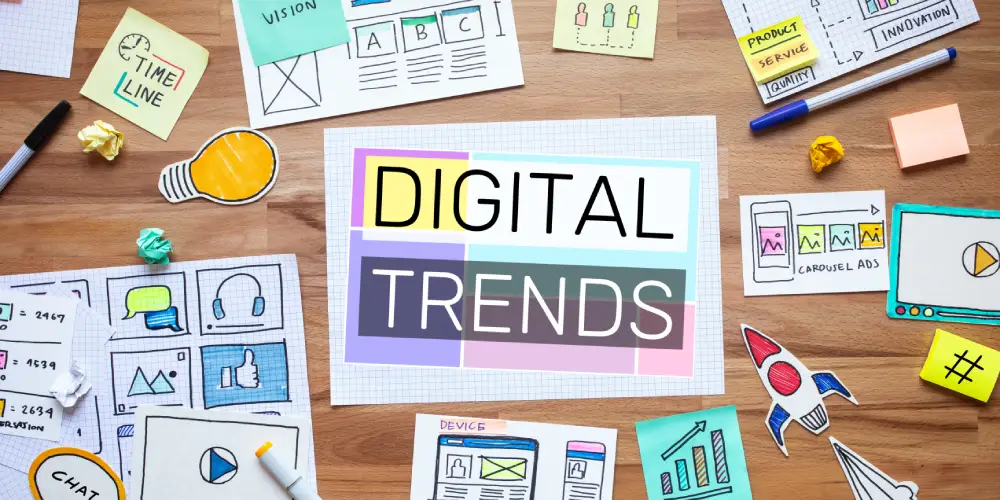
Digital marketing is a rapidly evolving platform, a world within a world that’s transforming almost every industry as we know it. Over the past few years, digital marketing witnessed groundbreaking advancements,redefining how brands engage with their audience, drive conversions, and foster meaningful connections. And as the transformation continues, we’ll have a look at some of the most game changing trends, technologies and integration with various industry verticals.
1. Personalization at Scale
Personalization remains paramount in digital marketing strategies, but the emphasis now lies on achieving it at scale. Advancements in AI and machine learning let marketers leverage data analytics in delivering hyper-targeted content tailored to individual preferences and behaviors. By harnessing predictive analytics and customer segmentation algorithms, brands can create personalized experiences across multiple touchpoints, driving higher engagement and conversion rates.
2. Voice Search Optimization
Voice-enabled devices have revolutionized the way consumers search for information and interact with brands. As voice search continues to gain prominence, optimizing content for voice queries becomes imperative for digital marketers. Structuring content in a conversational tone, incorporating long-tail keywords, and optimizing for local search are essential strategies to enhance visibility in voice search results and capture the growing audience relying on voice assistants like Siri, Alexa, and Google Assistant.
3. Immersive Experiences with Augmented Reality (AR) and Virtual Reality (VR)
Augmented Reality (AR) and Virtual Reality (VR) technologies have completely changed the way consumers engage with brands, offering immersive and interactive experiences. Marketers can leverage AR applications to allow customers to visualize products in their real-world environment before making a purchase decision, enhancing the shopping experience and reducing buyer hesitation.
Likewise, VR experiences enable brands to transport users to virtual environments, fostering deeper emotional connections and brand loyalty. Integrating AR filters on social media platforms and developing VR-powered product demonstrations are innovative ways to leverage these technologies for marketing purposes.
4. Blockchain for Transparency and Trust
Blockchain technology is not just limited to cryptocurrencies; its decentralized and immutable nature holds immense potential for enhancing transparency and trust in digital marketing ecosystems. By leveraging blockchain-based solutions, marketers can address concerns related to ad fraud, data privacy, and counterfeit products.
Smart contracts enable transparent and secure transactions, while blockchain-based verification ensures the authenticity of user-generated content and influencer partnerships. Incorporating blockchain into digital marketing strategies fosters trust among consumers and strengthens brand credibility in an era marked by growing privacy concerns.
5. Hyper-Personalized Content with Generative AI
Generative Artificial Intelligence (AI) is revolutionizing content creation by producing hyper-personalized and contextually relevant content at scale. Powered by advanced algorithms, generative AI can create compelling narratives, product descriptions, and even multimedia content tailored to specific audience segments.
Marketers can leverage generative AI to automate content creation workflows, optimize email marketing campaigns, and deliver personalized recommendations based on individual preferences and browsing history. By harnessing the power of AI-driven content generation, brands can enhance engagement, drive conversions, and streamline marketing operations.
6. Social Commerce and Shoppable Content
The convergence of social media and e-commerce has given rise to social commerce, transforming social platforms into seamless shopping destinations. Marketers can capitalize on the trend by incorporating shoppable posts, live shopping events, and interactive shopping experiences into their social media strategies.
Platforms like Instagram, Facebook, and TikTok offer native integrations for tagging products and facilitating direct purchases within the app, eliminating friction in the customer journey and driving impulse buying behavior. Leveraging user-generated content and influencer partnerships amplifies the reach and effectiveness of social commerce initiatives, driving revenue growth and fostering brand advocacy.
7. Data Privacy and Compliance
As concerns surrounding data privacy and regulatory compliance continue to escalate, marketers must prioritize ethical data practices and compliance with evolving regulations. The implementation of comprehensive data governance frameworks, consent management platforms, and robust security measures is essential to safeguarding consumer data and maintaining trust. Adhering to regulations such as the General Data Protection Regulation (GDPR) and the California Consumer Privacy Act (CCPA) mitigates legal risks as well as demonstrates a commitment to respecting consumer rights and privacy preferences.
8. Omnichannel Marketing Integration
Omnichannel marketing integration is critical for delivering cohesive and seamless customer experiences across multiple channels and devices. By unifying data from disparate sources and orchestrating consistent messaging and brand interactions, marketers can ensure continuity throughout the customer journey.
Leveraging marketing automation platforms and Customer Data Platforms (CDPs) enables real-time personalization and optimization across channels, driving engagement, loyalty, and revenue growth. Embracing an omnichannel approach empowers brands to meet consumers wherever they are and deliver tailored experiences that resonate across touchpoints.
9. Micro-Moments Marketing
Micro-moments refer to brief instances when consumers reflexively turn to their devices to fulfill an immediate need—whether it’s to learn, do, discover, or buy something. These micro-moments present valuable opportunities for brands to engage with their audience in meaningful ways.
By delivering relevant and timely content tailored to specific micro-moments, marketers can capture attention, influence purchase decisions, and drive conversions. For example, a food delivery app can capitalize on the “I-want-to-eat” micro-moment by offering personalized meal recommendations based on user preferences and location, ultimately driving orders and customer satisfaction.
10. Influencer Marketing Evolution
Influencer marketing continues to evolve, with brands shifting towards more authentic and purpose-driven collaborations. Micro and nano-influencers—individuals with smaller but highly engaged followings—are gaining traction as brands recognize the value of niche audiences and genuine connections.
The rise of virtual influencers—computer-generated personas designed to resonate with specific demographics—opens up new possibilities for brand partnerships and creative storytelling. By aligning with influencers who share their values and target audience, brands can amplify their message, enhance credibility, and foster genuine relationships with consumers.
11. Predictive Analytics for Marketing Forecasting
Predictive analytics empowers marketers to anticipate future trends, behaviors, and outcomes with greater accuracy, enabling data-driven decision-making and proactive campaign optimization. Analyzing these historical data allows shaping consumer behavior patterns, and market trends, predictive analytics models can forecast customer preferences, identify high-value segments, and optimize marketing strategies for maximum impact. For instance, e-commerce retailers can use predictive analytics to forecast demand for specific products, optimize pricing strategies, and personalize promotions to align with individual purchase intent, thereby maximizing revenue and customer satisfaction.
12. Sustainable Marketing Practices
With increasing environmental consciousness and social responsibility, sustainability has become a key consideration for consumers when choosing brands to support. Marketers can leverage sustainability as a differentiator by incorporating eco-friendly initiatives into their campaigns and messaging.
From promoting sustainable products and packaging to supporting charitable causes and environmental conservation efforts, brands can align their values with those of socially conscious consumers. Communicating transparently about their sustainability efforts and impact lets brands build trust, loyalty, and goodwill among environmentally aware consumers, driving long-term brand equity and positive social impact.
13. Interactive Content and Gamification
Interactive content and gamification techniques are effective ways to captivate audiences, drive engagement, and enhance brand interaction. From quizzes, polls, and surveys to interactive infographics and immersive storytelling experiences, interactive content encourages participation and fosters deeper connections with consumers.
Gamification elements such as challenges, rewards, and leaderboards incentivize user interaction and promote repeat engagement. For example, a fitness app can gamify workouts by incorporating challenges, progress tracking, and virtual rewards to motivate users and promote active lifestyles. Make your content interactive and enjoyable so that brands can leave a lasting impression and inspire action among their audience.
14. Hyperlocal Targeting
Hyperlocal targeting enables brands to deliver personalized marketing messages to audiences based on their precise location, allowing for highly targeted and contextually relevant campaigns. With a good grasp and professional know-how of geolocation data and proximity marketing technologies such as beacons and geofencing, marketers can reach consumers with localized offers, promotions, and recommendations in real-time.
For instance, a retail store can send push notifications to nearby customers with exclusive discounts or reminders about ongoing sales, driving foot traffic and conversions. Hyperlocal targeting enhances the relevance and effectiveness of marketing efforts, leading to higher engagement and conversion rates.
15. AI-Powered Chatbots and Conversational Marketing
AI-powered chatbots are transforming customer service and marketing interactions by providing instant, personalized assistance to users through natural language conversations. Whether it’s answering frequently asked questions, assisting with product recommendations, or facilitating transactions, chatbots streamline the customer journey and deliver seamless experiences across channels.
Further, conversational marketing platforms enable brands to engage prospects in personalized conversations at every stage of the buyer’s journey, nurturing leads and driving conversions in a more human-like manner. With AI-driven chatbots and conversational marketing strategies, brands can enhance customer satisfaction, improve efficiency, and drive revenue growth through meaningful interactions.
Staying informed, adaptable, and customer-centric, marketers can harness the power of digital transformation to forge deeper connections, inspire brand advocacy, and unlock new opportunities for success in the dynamic world of digital marketing.
Resource:

